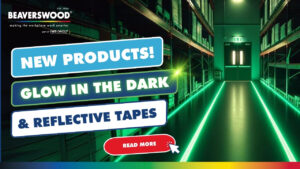We'd like you to imagine you've had a successful day at IKEA. You've noted down the new flat-pack furniture you want, you might have been lucky enough to eat their famous meatballs, and now you're popping into the warehouse to pick up your goodies.
One problem. This fictional IKEA warehouse has no labelling system.
And now you find yourself between the towering racks of products without a hope of ever locating the stock you require (unlike actual IKEA's, which have fantastic labelling systems).
What we're trying to get across is that the humble label might seem like a small detail, but in the world of warehousing, its impact is mighty. Without it, chaos reigns supreme, and inventory management, stock control, and order processing become nightmares.
That's why a good labelling system is the backbone of any successful warehouse. It:
- Provides a clear roadmap for workers, helping them locate products quickly and accurately.
- Ensures inventory is kept track of and stock is always replenished on time.
- Keeps orders flowing smoothly, so customers get what they need when they need it.
However, over time, labels can become faded, torn, or illegible, causing delays, errors, and even safety hazards. That's why it's essential to maintain your warehouse labelling system regularly.
In this blog post, we'll provide practical tips for extending the lifespan of your warehouse labels. We'll cover the importance of using high-quality labels, proper installation methods, regular inspection, cleaning and maintenance, and replacing old and damaged labels. Following these tips will ensure your warehouse labelling system remains accurate, reliable, and cost-effective.
So, let's get started! But before we dive in, we'd like to invite you to explore our warehouse labelling products. We manufacture a wide range of high-quality labels, ticket holders, and location markers to suit every need. And better yet, you could become a reseller of these popular products - just get in touch!

Use High-Quality Labels
Using high-quality labels is essential for the longevity and readability of your warehouse labelling system. Inferior quality labels may fade, smudge, or peel off over time, rendering them useless and causing confusion and errors.
Here are some tips for selecting the right type of label for your warehouse:
-
Consider the environment
Labels exposed to harsh conditions, such as extreme temperatures, moisture, dust, or chemicals, require special materials and adhesives to withstand the environment. For example, magnetic labels are the perfect solution for use in cold storage. Make sure to choose labels designed for your warehouse's specific conditions.
-
Choose the right size
Labels that are too small or too large may cause readability issues and affect scanning accuracy. Consider the size of your products and storage areas when selecting label sizes. For example, heavier duty and larger beams in the warehouse may require extra large 125mm high ticket holders.
-
Opt for clear printing
Labels that have smudged or faded printing are useless and can cause confusion. Choose labels that have clear, high-quality printing for easy reading and scanning.
With these tips in mind, you'll be able to select the perfect labels for your warehouse labelling system, ensuring longevity, readability, and accuracy for years to come.

Proper Installation
Proper installation of your warehouse labels is just as important as selecting the right type of label. Incorrect installation can lead to label damage, readability issues, and safety hazards.
We recommend using an experienced labelling manufacturer to install your location labelling system. At first glance, label installs might seem like an easy job (how hard can it be to slap some stickers around the place, right?). Yet we guarantee a DIY installation project will rarely go smoothly. This is because of:
-
Loss of productivity
Using internal warehouse workers will create its own set of labour challenges, especially when factored together with our second point…
-
Overruns
DIY installations often take far longer to complete than those carried out by specialists, due to the level of expertise required to install labels, signs, aisle and bay markers, dock signs, and more.
-
Mistakes
Out-of-sequence labels mean costly reprints and re-installations – eating up more valuable time and labour resources.
-
Poor end results
In-house workers rarely have the experience required to ensure the labels effectively adhere to the surface, leading to labels that curl, peel, and eventually fall to the floor.
So, if you'd like to let the experts handle it, don't hesitate to get in touch with us. We can carry out label installations in either new or occupied warehouses, working around your operations. Our service includes advice and consultation in the planning stage, hire of equipment, and installation fulfilled by trained and qualified personnel
However, for those of you who may still choose a DIY installation, we’d like to share some tips to aid you in the process:
-
Clean the surface
Before installing a label, make sure the surface is clean, dry, and free of any debris, dust, or grease. A dirty surface can affect the adhesive strength of the label.
-
Choose the right location
Labels should be installed in a visible, easily accessible location to ensure they can be read and scanned without difficulty. Avoid placing labels in areas that are prone to damage or obstruction.
-
Use proper tools
Use the correct tools for label installation to avoid damage to the label or the surface. Label applicators, label dispensers, and label protectors are some of the tools that can make the installation process smoother and safer.
-
Follow installation instructions
Always follow the manufacturer's installation instructions to ensure proper installation and longevity of the label.

Regular Inspection
Regular inspection of your warehouse labelling system is essential to ensure its accuracy and readability. Inspecting your labels frequently can help detect any issues early on and prevent errors and hold-ups. Here are some tips for inspecting your warehouse labels:
-
Set a schedule
Set a regular schedule for label inspection to ensure it's done consistently. Depending on the size of your warehouse and the level of activity, an inspection can be done daily, weekly, or monthly.
-
Check for damage
Check for any damage to the labels, such as fading, tearing, smudging, or peeling. Also, look for any signs of wear and tear or damage to the label's surface or location.
-
Verify accuracy
Verify the labels are accurate, readable, and scannable. Ensure the label information matches the product or location it represents and that the barcode or QR code can be scanned correctly.
-
Record the findings
Record the findings of each inspection, including any issues found and the actions taken to address them. This can help identify patterns or recurring issues and guide future maintenance and replacement decisions.

Cleaning and Maintenance
Proper cleaning and maintenance of your warehouse labels can extend their lifespan and readability. Over time, labels can accumulate dirt, dust, and other debris that can affect their adhesive strength and readability. Here are some tips for cleaning and maintaining your warehouse labels:
-
Use the right cleaning method
Use a cleaning method that’s appropriate for the label material, adhesive, and location. For example, some labels may require a mild detergent and water, while others may require a solvent-based cleaner. Avoid using abrasive cleaners or tools that can damage the label.
-
Test the cleaning method
Before cleaning a label, test the cleaning method on a small, inconspicuous area to ensure it doesn’t damage the label. This can help prevent costly mistakes and ensure the longevity of the label.
-
Clean regularly
Set a regular schedule for label cleaning, depending on the level of activity and the environment. Cleaning can be done daily, weekly, or monthly, depending on the needs of your warehouse.
-
Replace damaged labels
If a label is damaged beyond repair, replace it immediately to avoid errors, delays, and safety hazards. Replace the label with a high-quality label that’s appropriate for the location and environment.

Replacement of Old and Damaged Labels
As we've already highlighted, labels are the unsung heroes of the warehouse world. They guide workers to the right products, keep inventory organized, and ensure orders are fulfilled accurately and efficiently. But just like any hero, they can become worn out over time.
Faded, torn, smudged, or outdated labels are a recipe for disaster (think about being lost in that fictional IKEA warehouse again!). They can cause delays, errors, and even safety issues, leading to increased costs and decreased productivity. That's why it's crucial to keep a watchful eye on your labels and replace them as needed.
So, how can you tell when it's time to replace those heroic labels? Look out for signs of wear and tear, such as:
- Peeling edges
- Frayed corners
- Labels that have become difficult to read
- Outdated labels containing incorrect location information
Remember, labels play a big role in keeping your warehouse running like a well-oiled machine. So give them the care and attention they deserve and your warehouse (and bottom line) will thank you for it!

Conclusion
We hope your main takeaway from this article is that maintaining an excellent warehouse labelling system is essential for optimising the accuracy and efficiency of your operations.
First and foremost, you should invest in high-quality labels that are durable and reliable. Proper installation is also key, ensuring the labels are affixed correctly to prevent any peeling or damage. Finally, regular inspection and cleaning can go a long way in extending the lifespan of your labels and preventing errors.
And if you want to go the extra mile, you should consider investing in ticket or label holders to protect your labels from wear and tear. These holders can enhance the longevity of your labels and keep them looking their best for longer.
Remember: a fictional IKEA warehouse with no labels is a nightmare we wouldn't wish on anyone (in fact, we're getting a headache just thinking about it). So make sure you work with a reputable label manufacturer to get the best labels for your specific warehouse needs and ensure stock location is a breeze.
Plus, with a little TLC, your labelling system will be a source of pride for your warehouse operations, helping you achieve the ultimate goal of seamless, efficient, and accurate operations.
Become a Beaverswood® Reseller and Increase Your Revenue Today!
Established in 1984, we make the workplace work smarter with our range of visual management products, suitable for lean manufacturing and 5S - or any workplace that needs to be safe, productive, and in order.
With nearly forty years of reseller experience, not only are our products easy to use but so is our company! Our team of experts support you, our reseller, every step of the way; starting with an advanced reseller toolkit and continuing with drop-ship delivery, excellent lead times, and superb customer service.
We manufacture a wide range of labelling solutions to suit every need. Whether it's durable vinyl labels or high-quality polyester labels, we have everything required to keep labelling systems functioning optimally.
So, why not become a reseller of Beaverswood® warehouse labels and provide your customers with the best in the business? Our products are known for their durability and reusability, making them a cost-effective and sustainable option.
As we always say - Buy Beaverswood®, Buy Once!
T: 0118 979 6096




